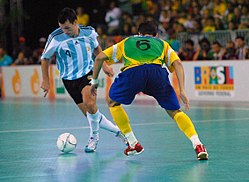Futebol de Salão

|
|
| Highest governing body | FIFA and AMF |
|---|---|
| Characteristics | |
| Contact | Yes |
| Team members | 5 per side |
| Type | Indoor |
| Equipment | Futsal ball |
| Venue | Futsal field/court |
| Presence | |
| Olympic | No |
| Paralympic | No |
Futsal, (literally "mini-football", "futebol de salão" i.e. "big room soccer"), is a variant of association football played on a hard court, smaller than a football pitch, and mainly indoors. It can be considered a version of five-a-side football.
Futsal is played between two teams of five players each, one of whom is the goalkeeper. Unlimited substitutions are permitted. Unlike some other forms of indoor football, the game is played on a hard court surface delimited by lines; walls or boards are not used. Futsal is also played with a smaller ball. The surface, ball, and rules create an emphasis on improvisation, creativity, and technique as well as ball control and passing in small spaces.
Futsal comes from Spanish fútbol sala or fútbol de salón and from Portuguese futebol de salão. The term is commonly translated as "indoor football" but a more literal translation is "hall/lounge football". During the sport's second world championships held in Madrid in 1985, the Spanish name fútbol sala was used. Since then, all other names have been officially and internationally changed to futsal. The naming was due to a dispute between FIFUSA (the predecessor to the AMF) and FIFA over the name of fútbol, FIFUSA has registered the word fut-sal in 1985 (Madrid, Spain). Since then FIFA has also started using the term futsal. The name has been translated into Italian as calcio a 5 or football sala, and French as football de salle.
"Futsal" started in 1930 when Juan Carlos Ceriani[], a teacher in Montevideo, Uruguay, created a version of indoor football for recreation in YMCAs. This new sport was originally developed for playing on basketball courts, and a rule book was published in September 1933. His goal was to create a team game that could be played indoor or outdoor but that was similar to football, which became quite popular there after Uruguay won the 1930 World Cup and gold medals in the 1924 and 1928 Summer Olympics.
...
Wikipedia
